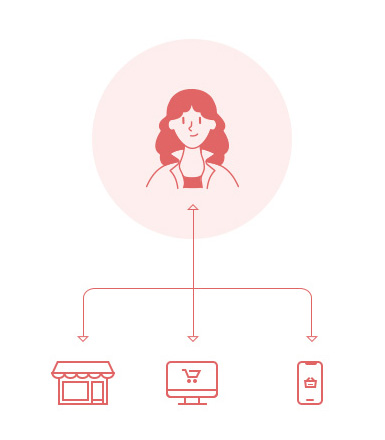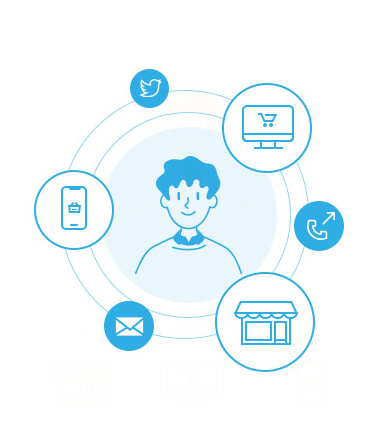
Table of Contents
Today's customers are online 24 hours a day, 7 days a week. When shopping, they switch between various channels and expect a consistent shopping experience. To keep up with this, companies need to serve their customers on all communication channels instead of one touchpoint. Thanks to different business models, companies can keep pace with customers' wishes and create a positive customer experience.
Multichannel, omnichannel and cross-channel - these are three terms that many retailers have already familiarized themselves with. They are three different business concepts that focus on building good and successful customer communication.
Companies are increasingly asking themselves how they can win over customers faster and address them better. This can be achieved by introducing multichannel, omnichannel or cross-channel marketing. What do these concepts have in common and what are the main differences? Here you will find out using examples.

What is multichannel?
Multichannel means that the company uses several channels to bring the product to the customer. For example, products are sold on a website, in an app and offline in a store. Different channels also imply different ways of making contact. The sales channels are not connected to each other and are organized independently of each other. For example, customers can order on the website or buy in the store, but they have no way of continuing their information and purchasing process across channels, as the integration of the sales channels is not guaranteed. Data analysis is also carried out separately, with each team analyzing different data for each channel.

What is Cross Channel?
Cross channel commerce is still technically multi-channel, but uses a more seamless approach. Various channels are mixed and matched to ensure a seamless customer experience. Thanks to cross-channel marketing, the customer has several channels at their disposal that are linked to each other. This allows the customer to obtain information across channels and also place orders.
The idea is to mix the sales channels in order to smooth the customer experience. For example, the "click and collect" model: ordering in the online store, picking up the goods in store or trying them on in store and having them delivered to your home - this is made possible with the cross-channel business model. This allows companies to interact with customers on several platforms at the same time.
Advantages of cross channel marketing:
Cross-channel campaigns
Perhaps the most important benefit of cross-channel commerce is personalized and automated messaging campaigns. Cross-channel campaigns have the potential to be more engaging and relevant to your customers because they incorporate behavioral data from every touchpoint, not just the current channel!!
Improved customer understanding
Thanks to cross-channel marketing, companies can collect information about their existing customers from all communication channels. Brands use this data to divide their customers into groups and create relevant offers.
Greater accessibility of the target group
The use of multiple communication channels increases the likelihood that the target group will actually be reached and that advertising messages will not quickly get lost in the masses. A cross-channel strategy increases the chances of advertising reaching the right customer at the right time.
Better shopping experience
Cross-channel commerce ensures a positive shopping experience, which contributes significantly to customer satisfaction. As is generally known, satisfied customers become regular customers who later recommend the company's products or services to their friends and family.
Easy channel switching
A customer can use chats to find out about an offer that they previously received by email after placing an online order. Cross-channel marketing ensures that customers can switch communication channels at any time and find out more about the products and services regardless of the channel used.
Multi Сhannel vs. cross channel
In comparison to cross-channel, multichannel means that the channels are operated independently of each other. The purchase process only takes place in one channel. If an inquiry is made in one channel, the purchase process cannot be continued in another channel. Although the sales channels are coordinated, they are operated independently of each other. The interactions during the customer journey are considered and evaluated individually on each channel in multichannel.
Cross-channel marketing, on the other hand, means that several channels are coordinated and the interactions between these channels are taken into account when analyzing the data. Based on this information, for example through targeting, the desired target group can be specifically addressed. Online targeting is often based on the use of cookies. This is used to analyze the surfing behavior of users and display suitable advertising in order to increase the conversion rate of an ad or banner.
Cross-channel targeting also allows users to switch between channels during the information or purchase process without losing information. For example, if a visitor arrives at the website via a specific communication channel but does not make a purchase, the user is addressed with targeted advertisements using retargeting, e.g. on Facebook.
What is omnichannel?
 Omnichannel is a broad concept that can be seen as a further development of cross-channel. The focus is clearly on the customer themselves and their relationship with the provider. Not only are multiple channels used that interact with each other, but these channels also work together seamlessly and often simultaneously to achieve a sales goal. Data from previous user interactions is collected from all channels, such as which products have been viewed and purchased, which ads have been viewed and what the user has clicked on so that they do not see ads for products they have already purchased.
Omnichannel is a broad concept that can be seen as a further development of cross-channel. The focus is clearly on the customer themselves and their relationship with the provider. Not only are multiple channels used that interact with each other, but these channels also work together seamlessly and often simultaneously to achieve a sales goal. Data from previous user interactions is collected from all channels, such as which products have been viewed and purchased, which ads have been viewed and what the user has clicked on so that they do not see ads for products they have already purchased.
The aim of omnichannel is to remove the boundaries between the online and offline world and ensure a flawless purchasing process for the customer.
Customers are given access to real-time information wherever and whenever they want, regardless of the channel used. With the omnichannel strategy, customers are accompanied on all communication channels with favored products and search settings. All possible touchpoints can be used in all possible combinations.
A good example of a successful omnichannel strategy is the provider Netflix. Because regardless of which device you watch a movie on - a smartphone, tablet or laptop - Netflix collects this data to improve individual recommendations. For example, you are watching a movie on your smartphone and press the pause button because you have decided to watch the sequel on your laptop - playback will then start at the exact point where the movie was paused! This keeps customers in constant contact with the company.
Omnichannel vs. Multichannel
Multichannel marketing can be seen as part of the omnichannel, but not vice versa. The purchasing process in the multichannel approach takes place in one sales channel and cannot reference another channel. The following applies to multichannel: each channel acts independently and has its own database. This often results in separate processes that lead to an inconsistent customer journey.
Omnichannel, on the other hand, aligns all sales channels to create a uniform and cross-channel brand experience. The result is a single shopping environment in which customers can move freely. With the omnichannel strategy, you can see the whole picture and summarize information from all channels about each customer. . All sales channels are interlinked and can be used simultaneously during the purchasing process. Compared to multichannel, brands that pursue omnichannel conversions have higher customer loyalty and can create greater trust in the brand.
Cross channel vs. omnichannel
Cross-channel offers a convenient shopping experience thanks to the combination of multiple channels. Which channels are integrated depends on the objectives of the marketing campaign, the marketing resources and the target group. Many brands combine several channels at the same time - these complement each other and increase the overall impact on the audience.
Omnichannel marketing is the most advanced form of marketing compared to cross-channel and multichannel marketing. Omnichannel uses several channels at the same time, always putting the customer at the center. The omnichannel approach ensures a positive, cross-channel customer experience. The customer is on the move on many sales channels at the same time and has several touchpoints. In contrast to the cross-channel concept, omnichannel not only merges the sales channels, but also the communication channels. This means that the preferences and inputs of individual customers registered on one channel are accessible to all channels. This type of marketing is becoming increasingly popular, as customers have complete transparency and accessibility when shopping. The aim of the omnichannel strategy is to collect data from all channels and use it to improve the customer experience. PIM software such as AtroPIM can also help with this.
Conclusion
All of these strategies, whether multichannel, cross-channel or omnichannel, improve the shopping experience for the customer. In any case, it is worth thinking about a cross-channel business model. An omnichannel strategy will certainly be the most expensive, and therefore not the best for everyone.
Whether you opt for multichannel, cross-channel or omnichannel marketing, the most important thing is that the customer experience is at the forefront of your marketing strategy. Making the buying process as simple and intuitive as possible is key to creating better buying experiences for your customers.

